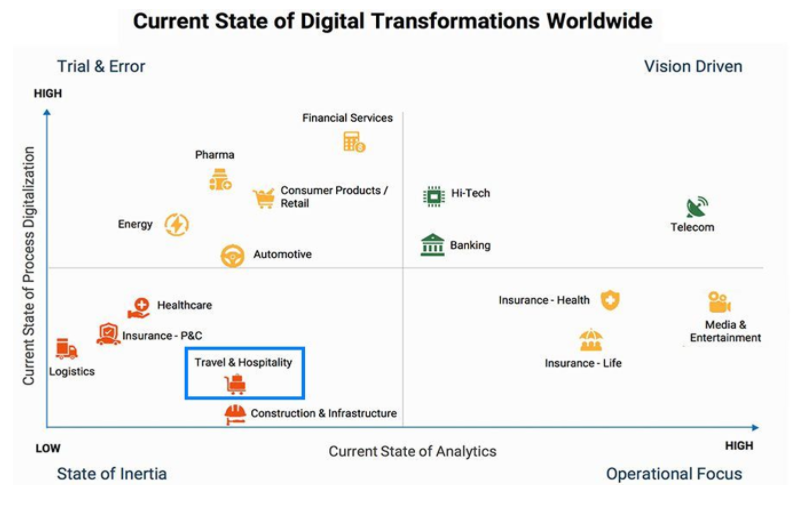The travel industry has been increasingly adopting technology to enhance various aspects of the travel experience, from planning and booking to the actual journey and post-trip activities.
Digital transformation is the pivotal process of leveraging digital technologies to fundamentally change how businesses operate and deliver value to their customers and partners. This shift of business towards digitalization transcends traditional roles like sales, marketing, and customer service. Rather, it entails a reorientation that puts customers in the very center.
According to Markets And Markets, the digital transformation market size is projected to grow at a compound annual growth rate of 24.1%, from $695.5 billion in 2023 to $3,144.9 billion in 2030.
While travel has made significant strides in adopting technology, the process might be perceived as slow or challenging because the industry is ever-evolving, highly fragmented, lacking standardized processes and interoperability between systems, fear of not getting the return on investment, customers’ expectations changing constantly, and so on.
Digital Transformation: Travel Industry is Well Behind Others
The overall trend for digital transformation is slow, and the changes in the travel industry are not developing at the same pace as in most industries, like the banking industry or telecom.

From our experience of talking and working with different Tour Operators, DMCs, and Travel Agencies worldwide, there are several main reasons for this:
- Tourism is a people business. Strong people relationships are crucial: relationships with suppliers, employees, and customers. It is a strength of the industry, and at the same time, it can also be an obstacle to mindset change and adopting technology.
- There was never enough time to focus on business processes. Before the recent pandemic, the travel industry was the second-fastest-growing sector in the world. In this fast-growing market, where demand exceeds supply, travel agents never had enough time to focus on business processes. Some quick wins and smaller adjustments were made on a daily basis, hiring more people was a logical option to cover all administration and back-office tasks.
- The travel industry relies on legacy systems and infrastructure. Many established players in the tourism industry, such as travel agencies, airlines, and tour operators, rely on legacy systems and infrastructure that may not easily integrate with new technologies. Updating these systems can be complex and costly, leading to resistance or delays in adoption.
- The travel industry is highly fragmented and complex. With numerous stakeholders involved in different stages of the travel booking processes, coordinating technology adoption across these diverse sectors can be challenging, especially when there is a lack of standardized processes and interoperability between systems.
- Travel companies worry about cost and return on investment. Implementing new technology often requires significant upfront investment in terms of both financial resources and staff training. Businesses may hesitate to allocate resources to technology projects without a clear understanding of the potential return on investment or a proven track record of success.
- Digital divide and access issues exist. While technology adoption is increasing globally, disparities in digital infrastructure and literacy access still exist, particularly in developing countries and remote regions. Bridging the digital divide requires investment in infrastructure, education, and equitable access to technology, which may take time to achieve.
According to a 2023 AWS and Skift survey, despite 95% of travel executives stating that digital transformation is very or somewhat important to their company’s overall strategy and success, legacy system maintenance and upkeep remain their primary focus.
Changes in Customers’ Behaviour
So, while the world keeps moving forward, together with technology, the travel industry needs to keep in step. Besides that, these past four years have introduced a lot of changes, and there are some strong lingering effects of the pandemic on the travel trends:
- The past 4 years have truly been dynamic regarding changes in customer behavior, decision-making processes, and values. Travelers expect an on-demand and personalized service with seamless communication through online channels. We live in a customer-centric world, and travel companies need to meet their customers where they are and serve them in the most intuitive manner possible. We recently wrote about the new travel trends, so take a look.
- Online channel presence, seamless booking process, dynamic packages, or flexible cancellation policies are just some examples that are on the agenda right now, and all of these imply flexible and adaptable business processes and backbone that can support all of the mentioned as well as the upcoming changes.
One of Lemax’s clients from New Zealand managed to increase the number of bookings during the pandemic with a fast reaction to new market changes and technology adoption. They decided to focus on domestic travel, although they were mainly inbound before the pandemic, and introduced online as a sales channel.
Our team gathered insights on the topic of digital transformation at the ITB expo in Berlin in March 2024. It came as no surprise that many Tour operators, Travel agents, and DMCs who gathered at the event could very much relate to what our team was saying.

How Can Technology Help?
It takes two hours on average for a travel agent to issue a quotation to a customer. That means that one travel agent can daily produce only up to 3.5 quotations, while there are some easily automated repetitive steps in this process where technology can step in.
Carl Cronje, our client’s Expat Explore’s co-founder, points out that, with Lemax, they will now have a fully integrated platform instead of having their product team work in one and their sales and customer service teams in another:
“Our whole product catalog was done manually in Excel – that will also change. All the information will now be integrated into one place and easily reachable to every team member. This will also help in the decision-making process. Data integrity with a system like Lemax will be something of great value for us.”
With different resource allocations, travel companies could focus more on the ‘next generation of travelers’ by automating repetitive work and freeing up their time to be focused on the customer and enhancing customer experience.
What Does Adopting New Technology Look Like in Day-to-day Work?
Lemax is covering the end-to-end business process – from building up the product, selling the product by communicating with customers in every step of the booking lifecycle (from inquiry to invoicing), as well as communicating with suppliers and partners before and after customer travel.
Back-and-forth communication with customers on one side and suppliers on the other side, pen and paper processes, many supporting spreadsheets and files, a bunch of disconnected systems and tools, and the risk of making many potential mistakes in the process. All of these could easily be quantified and measured and this is exactly how we are approaching our clients in the sales process. We assess a travel company’s current process, replicate it in Lemax software, and measure before and after in concrete metrics such as time per quotation, win rate, number of changes, and mistakes.
Overall, while the travel industry may face challenges in adopting technology, there is a growing recognition of the importance of digital innovation for improving efficiency and revenue growth, enhancing customer experiences, and staying competitive in a rapidly evolving market. A proper technology strategy helps the travel organization focus on its key business, with technology acting as a business enabler and not a problem child.
Are you interested in how Lemax software can help your travel company? Request a demo and find out.



